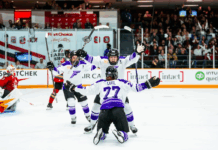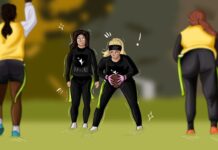
Picture the silence of waking up at five in the morning every day—dedicating hours to perfecting your craft, all for the chance to one day be recognized as a Canadian student athlete.
But, sometimes all it takes is one mistake on social media to shatter your hopes of playing at the next level.
One post, one video, one comment, one click—and it’s all gone.
It’s a risk student athletes often hear about from coaches and scouts, on the benefits and disadvantages social media can have on players getting recruited to university sports teams.
Though it can be an excellent tool for coaches to connect and interact with players, stories of revoking athletic scholarships and letters of intent due to a player posting inappropriate content on Twitter, Instagram, or Facebook are always in the back of future recruits’ minds.
The increased exposure from these outlets has added another layer of difficulty for athletes looking to maintain a positive reputation.
“Everything is at risk, for real,” said Dominic Walker, a first-year wide receiver for Carleton University’s football team.
Walker chose to transfer to the Ravens’ program from the NCAA last year after being recruited by Jon Edouard, fourth-year defensive back and hometown friend.
Walker, a Florida native, recounts how social media played a role in his recruitment five years ago when he was a top high school football prospect in the ESPN 300 scouting ranks, and had a choice between taking his talents to Auburn or Nebraska University.
As a student athlete for Maynard Evans High School, Walker’s high school coaches cautioned the highly touted wide receiver when he started to receive scholarship offers. Their advice was simple: “before you post anything at all, make sure it’s something you want to be known for.”
While he ultimately committed to Auburn, fans from both schools did everything they could to try and convince the then high school senior through social media. The attention resulted in Walker receiving a substantial hike in Instagram, Twitter, and Facebook followers, as well as publicity.
“Everything operates off social media,” Walker said. “If you want to get exposure; if you want to get noticed; if you want to know about certain events, combines, everything that goes on, it all goes through social media.”
Canadian users are no exception when it comes operating social media. According to the 2018 Report on Canadian Social Media Use Statistics, 84 per cent of Canadians used Facebook as a means to interact online while YouTube followed with 50 per cent. At least 69 per cent of those Canadian users used Facebook once per month or more.
Since coming to Carleton, Walker has spoken with head coach Steve Sumarah and the rest of the football staff on their expectations for players to ensure they don’t hurt their careers or the school’s reputation when they interact online.
It’s a massive difference from his time at Auburn, Walker said, where a school representative was responsible for monitoring each player’s social media activity.
“If you pull something, they automatically knew—‘all right they posted this at this time. Boom. What did he post? Was it good? Alright, we good,’” Walker said. ‘“Oh, he posted this. Nah, we need to tell him to take that down right now ASAP before it gets out.’”
The 2018 U Sports recruiting regulations state coaches can contact ‘prospective student-athletes’ in-person, over the phone, email, text, and by social media during the year, as long as the player has not signed a letter of intent to a different school.
Jimmy Sanderson, a professor in sports management at Texas Tech University, has been studying social media use among athletes since 2006. He has found future high school recruits need to be aware of how old posts can affect their chances of getting recruited.
“It’s just a very interesting time right now because we’re starting to have more and more volume if you will, or more history of what athletes have posted and that opens up more opportunity for scrutiny,” Sanderson said.
Specialized recruiting organizations such as Next Level U Sports are looking to create a different route for underexposed student athletes by helping them receive exposure from Canadian and American schools.
Over the last two years, the company has helped 70 Canadian student athletes secure athletic scholarships.
“We’re not a revenue-based model where we accept any athlete,” said Ryan Neceski, a head recruiter who established the company in 2017 after playing collegiate soccer in both the U.S. and Canada.
“We evaluate athletes beforehand to make sure that they are high-level elite athletes, and that’s a result of our high success rate of placing these athletes at schools.”
Sanderson, in a 2012 study on student athletes and social media, found how Twitter created a hostile environment in which highly skilled NCAA student athletes in the U.S. felt encouraged to respond to negative tweets—these athletes were often banned from using the outlet by their schools as a result.
Sanderson also found the players involved in the study were educated enough in the subject to refrain from responding quickly to the criticism in fear of it becoming a potential problem in the future.
Neceski understood this reality first-hand while playing university soccer and through talking with university coaches in North America as part of Next Level U Sports.
“Coaches all around have been—even when I was playing—they’ve been emphasizing ‘watch what you put on social media’ . . . we obviously emphasize the point of ‘watch what you put’ even after you’re with us during your collegiate career,” Neceski said.
“Because as much as it can hurt you while you are even at the school . . . it can hurt you down the line if you ever take the professional route as well,” Neceski added
However, not every coach is a fan of using social media to analyze potential recruits.
Carleton women’s hockey head coach Pierre Alain requires all commits to sign a contract in terms of team rules and following social media policies.
“So far, we haven’t picked a player in my five years that we had to decommit because of that social media point. We haven’t,” Alain said. “I’m not saying that it’s not important and it’s not something that we should look at, but so far, we really haven’t put a lot of emphasis on that.”
Despite the risks involving social media, many student athletes have found success in using platforms such as Hudl and YouTube to post film of game highlights and attract attention from university scouts and coaches.
Hudl currently has more than 160,000 active teams and over 4.3 million users varying from local to professional organizations.
It’s a tool that helped former Ravens men’s hockey head coach Marty Johnson to recruit now fourth-year forward Travis Douglas to his team.
Before arriving at Carleton in 2016, Johnson was able to see game film of Douglas playing in the NCAA after being forwarded online clips by his previous coaches from American International College.
“I think it’s a great tool for the athlete. I mean, it’s still with the direction things are going now,” Douglas said about online sports profiles. “It’s easier just for a coach to open up their laptop and look at a highlight film than it is to travel, let’s say, across the country to see you play.”
Although Douglas isn’t “crazy into” the use of social media on and off the ice, he understands the repercussions it could have on a player’s reputation—particularly when he is in the process of applying for graduate school.
“If you have a profile, it kind of allows you to express yourself in; ‘okay, this is who I am. I’m a hockey player, but I’m not just a hockey player,’” Douglas said. “It’s a fine line, for sure.”
Image by Grant Vasos





